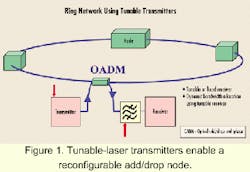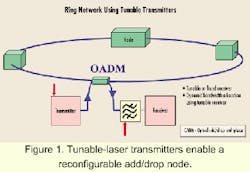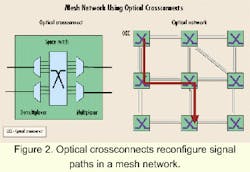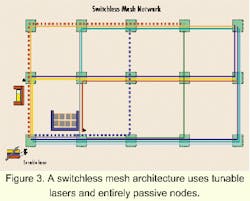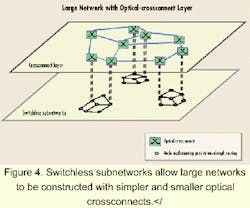Emerging tunable-laser applications in optical networks
Robert Plastow Altitun AB
The Internet as we know it today exists because of the high-capacity transport infrastructure provided by dense wavelength-division multiplexing (DWDM) optical-fiber links. DWDM technology allows network operators to send multiple wavelength signals down a single fiber, enabling huge growth in network capacity at reasonable cost. With the expected exponential traffic growth, it is clear that optical-network capacity must continue to scale dramatically.
To enable this growth without repeatedly hitting bottlenecks, service providers must be able to assign, and re-assign, wavelengths as needed throughout the network. Laser transmitters that can tune wavelengths to any desired channel are a key element in these future network architectures. Network operators such as Sprint and Telenor are already working with tunable lasers to overcome the capacity barriers of existing systems.
The need to flexibly provide more bandwidth is the driving force behind future optical-network requirements. Service providers will require scalability of factors of 10 beyond the network's initial installed capacity. Rapid service activation is another requisite to allow carriers to provide high-capacity links as needed-moving from the current provisioning times of months for OC-192 (10-Gbit/sec) circuits to true bandwidth on demand. Future optical networks must also handle multiple traffic types, offer the lowest cost of ownership, and provide seamless restoration (survivability).
All of these requirements will drive network functionality into the optical layer. The use of reconfigurable multiwavelength transport will allow service providers to offer bandwidth on demand, but also provide the survivability and quality of service needed.
Tunable-laser transmitters can provide a way to achieve network functionality in the optical layer in a reliable and flexible manner, using commercially available technology. In particular, the physical route taken by an optical signal can be altered at the transmitter by simply changing the wavelength and using either passive or tunable WDM filters at each node to determine the signal route.This network architecture enables protection, restoration, and dynamic provisioning of capacity in a reliable, simple fashion, using inherently low-cost, commercially available technology to realize the wavelength routers. With 100 available wavelengths, a network of at least 10 to 16 nodes can be supported, depending on the total capacity requirements. This approach makes a switchless mesh architecture suitable for regional and national networks. Larger networks can be accommodated by using OXCs to interconnect a number of switchless subnetworks (see Figure 4). Alternatively, subnetworks can be linked using an additional switchless network with optical-to-electrical-to-optical (OEO) conversion at its boundaries.
Telenor's testbed comprised nine centrally controlled nodes with fiber spans of 50 to 60 km and optical channels at 2.5 and 10 Gbits/sec. Programmable tunable lasers from three suppliers were used in the testbed. These devices proved to be precise and reliable for applications in a DWDM network with 100 optical channels and a channel spacing of 50 GHz. The testbed results will soon be published.
The Telenor demonstration showed that a high-performance all-optical network can be built without OXCs and that a switchless mesh architecture is scalable to a large size. The switchless mesh architecture does not render OXCs superfluous, however. Rather, it shows that smaller OXCs may suffice if programmable laser transmitters are used. Moreover, the switchless mesh architecture has the potential to realize fast reconfigurability and support network functionality steered exclusively from the transmitter, allowing additional network features that better serve a data-dominated environment.
System manufacturers such as Marconi and Alcatel have already announced plans for flexible optical networks based on tunable lasers. These initial systems are all based on routing an entire wavelength through a system. The ultimate use of capacity, however, will come when optical packets can be routed by wavelength.
Wavelength-routed all-optical packet networks have the potential to offer high-throughput and format-independent routing for future packet-based communications applications. One promising application is to efficiently route the large amounts of data generated in metropolitan areas. Backbone technologies, which now operate at Tbit/sec rates, need to connect to asynchronous digital subscriber line (ADSL) and cable-modem access technologies that operate at slower Mbit/sec rates. Thus, carriers are building high-capacity WDM metro politan area networks (MANs).
Such a MAN is being developed by Sprint Advanced Technology Laboratories and Stanford University's Optical Communications Research Laboratory. Known as the Hybrid Opto-electronic Ring Network (HORNET) [ref. 1, 2], the MAN uses a WDM ring that is optimized for data traffic-significant since telecommunications traffic will soon be dominated by data, not voice. The HORNET architecture makes use of rapidly tunable lasers to increase network capacity. Instead of maintaining point-to-point connections between each node, the nodes on the ring hop from one wavelength to another on a packet-by-packet basis, thus cutting in half the network resources required, compared to electrical switching at a central hub [ref. 2]. In addition to the fast tunable transmitters, HORNET uses an optical CSMA/CA (carrier-sense multiple access with collision avoidance) media-access scheme. Both of these techniques have been successfully demonstrated recently [ref. 3].
HORNET is a metro ring with a circumference of up to 100 km, which can support 100 access points (APs). These APs connect local- and campus-area networks to the ring. Each AP has a fixed, single-wavelength optical drop and a fast tunable transmitter, which can transmit on any wavelength in the network. All APs are able to transmit on all wavelengths in the network, so a protocol is required to determine access to the wavelengths.
In the CSMA/CA approach used in HORNET, the AP monitors all wavelengths in the network. The AP only sends a packet when it has found the opening. Rather than monitor each wavelength individually, HORNET utilizes subcarrier tones multiplexed onto each packet. Each wavelength is associated with a unique subcarrier frequency, which allows the AP to identify the wavelength of each packet. This approach is both cheaper and easier than measuring the wavelength directly. As packets travel around the ring, they carry with them a subcarrier tone, which indicates the presence of a packet on the associated wavelength. Each node taps off a small amount of optical power from the ring to detect the subcarrier signals. If a subcarrier at a particular frequency is present, the node knows that the corresponding wavelength is currently unavailable.
HORNET is possible because of the availability of rapidly tunable-laser sources. Notably, the Sprint and Stanford development team also demonstrated 4-nsec fine-tuning (0.8-nm channel separation) of the grating-coupled sampled-reflector (GCSR) laser transmitters used in HORNET [ref 4]. This demonstration is important because a wavelength-tuning time of 10 nsec or less is required for efficient transmission of 2.5-Gbit/sec Asynchronous Transfer Mode (ATM) traffic through HORNET.
The use of a rapidly tunable laser in conjunction with a relatively simple passive optical network to allow packets to be switched to different destinations can also be applied to other network configurations and even to standalone enterprise elements such as core-packet switches.
Another network under development is the Optical Packet Experimental Routing Architecture (OPERA) project [ref.4]. This architecture is based on packet routing using optical network interface routers (ONIR) and arrayed waveguide routers. Developers of this network have demonstrated packet-rate wavelength conversion and packet forwarding based on subcarrier multiplexing (SCM) header recovery. Wavelength conversion was performed at the packet rate using a high-speed tunable laser similar to the device used in the HORNET testbed.
Laser transmitters that can tune wavelengths to any desired channel represent a key element in optical-network architectures. Recent demonstrations by operators such as Sprint and Telenor show how carriers can overcome the capacity barriers of existing systems using this technology. One emerging application is in switchless mesh networks that use a simple, all-optical architecture for regional and national networks. Another application of this technology is in optical packet-switched rings that use laser sources to switch signals in nanosecond timescales to provide a high-capacity MAN. These architectures leverage the unique capabilities of tunable lasers to provide networks that will improve efficiency, boost reliability and allow carriers to cost-effectively supply bandwidth-on-demand.
Robert Plastow is the chief technical officer for Altitun AB (Stockholm). He is based in the U.K. office.
- S. M. Gemelos, K. Shrikhande, D. Wonglumsom, I. M. White, T. Ono, L. G. Kazovsky, "HORNET: A Packet-Switched WDM Metropolitan Area Network," CNIT '99, Portofino, Italy.
- T. Ono, S. Gemelos, I. White, L. G. Kazovsky, "Latency Characteristics of Wavelength-Switched Packets in WDM Multi-Hop Ring Network," OFC/IOOC '99 Technical Digest, San Diego, CA,ThM8, pp. 183-185.
- "Experimental Demonstration of a Media Access Protocol for HORNET: A WDM Multiple Access Metropolitan Area Ring Network," I. M. White, Y. Fukashiro, K. Shrikhande, D. Wonglumsom, M.S. Rogge, M. Avenarius, and L.G. Kazovsky OFC 2000 Technical Digest Paper WD3.
- A. Carena, M. D. Vaughn, R. Gaudino, M. Shell, and D. J. Blumenthal, "OPERA: An Optical Packet Experimental Routing Architecture with Label Swapping Capability," Journal of Lightwave Technology, vol. 16, no. 12, pp. 2135-2145.
